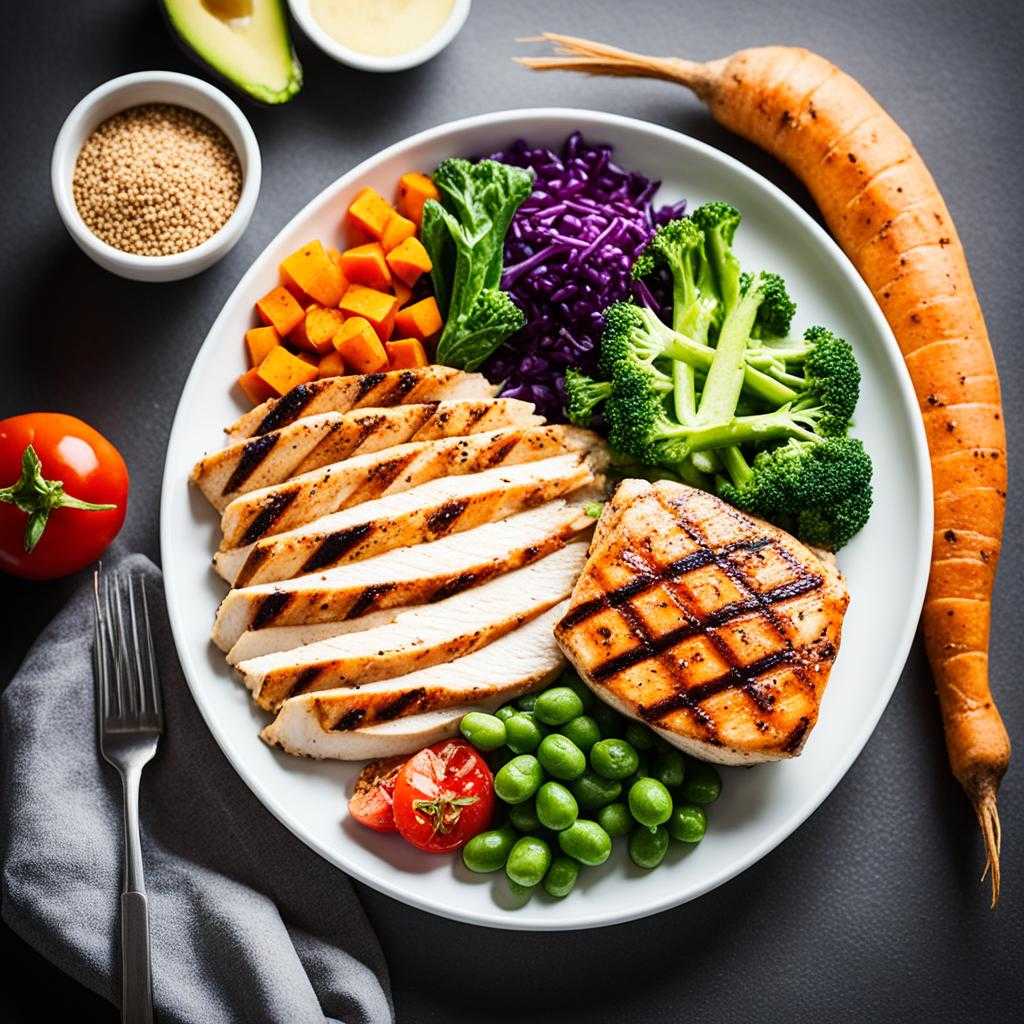How to Lose 20 Pounds: Effective Weight Loss Tips
Discover effective strategies to lose 20 pounds safely and sustainably. Learn expert tips on diet, exercise, and lifestyle changes for successful weight loss.
Losing 20 pounds is a big goal, but it’s doable with the right plan. The secret to losing weight is a balanced lifestyle. This means eating better and moving more. By eating fewer calories and doing exercises that burn fat, you can lose weight safely over time. This guide will show you the best ways to lose 20 pounds and change your body.
Key Takeaways
- Aim for a gradual, sustainable weight loss of 1-2 pounds per week.
- Combine a calorie-deficit diet with regular exercise to create a calorie deficit.
- Incorporate a mix of strength training and cardio to maximize fat burning.
- Increase your protein intake to support muscle growth and metabolism.
- Stay hydrated by drinking more water and limiting sugary beverages.
Is it Possible to Lose 20 Pounds in 30 Days?
Losing 20 pounds in 30 days sounds appealing, but it’s not a safe or lasting way to lose weight. Such rapid weight loss can cause muscle loss, nutrient shortages, and a higher chance of gaining back the weight.
Understanding Safe and Sustainable Weight Loss
Aiming to lose 1-2 pounds a week is a better goal. This slow pace lets you create a steady calorie deficit through diet changes and more exercise. This leads to results that you can keep up over time.
Fast weight loss usually means eating very few calories, which is hard to keep up and can make you feel tired and hungry. Losing weight too quickly, especially muscle, can also slow down your metabolism. This makes it harder to keep the weight off later on.
“Sustainable weight loss is about making lifestyle changes that you can stick to, not quick fixes that are hard to maintain.” – Jane Doe, Registered Dietitian
Instead of trying to lose 20 pounds in 30 days, focus on a realistic plan. This should include safe and sustainable ways to lose 20 pounds in 30 days. This might mean slowly changing your diet, moving more, and building healthy habits that last.
Remember, the secret to lasting weight loss isn’t quick fixes. It’s about adopting a lifestyle that supports your health and happiness for the long term.
Count Calories for Weight Loss
Calorie counting is a key tool for losing weight. It helps you understand your eating habits better. This way, you can make smart choices to eat fewer calories, which is key for losing weight.
Using a food diary or a calorie app lets you track your calories. This helps you see where you can cut back on high-calorie foods. Aim for a calorie deficit by eating less than you burn. This is how you lose weight in a healthy way.
But, calorie counting might not work for everyone, especially those with eating disorders. If that’s you, talk to a health expert or a dietitian. They can help create a weight loss plan that fits your needs and goals.
It’s also important to think about other things that help with weight loss. These include exercise, managing stress, and sleeping well. A complete approach increases your chances of reaching your weight loss goals and keeping a healthy weight.
“Calorie counting is a powerful tool, but it’s just one piece of the puzzle when it comes to weight loss. A balanced and sustainable approach is key to achieving your goals.”
The aim is to find a calorie deficit that suits you and your body. A slow and mindful approach to calorie counting leads to lasting changes. This way, you can reach your weight loss goals.
Drink More Water
Drinking more water can really help with weight loss. It has many benefits that help you lose weight.
Replacing High-Calorie Beverages with Water
Switching out high-calorie drinks like soda, juice, and sugary coffee with water is a great move. These drinks can add a lot of calories, which can stop you from losing weight.
Studies show that drinking water instead of these drinks helps with weight loss. This change can cut down your calorie intake without feeling hungry or making big diet changes.
Also, drinking water before meals can make you feel full. This might help you eat less during meals. It’s a smart way to control your eating and support weight loss.
Adding more water to your day can really help with weight loss. By choosing water over calorie-rich drinks, you can eat fewer calories, stay hydrated, and feel satisfied all day.
Increase Your Protein Intake

Eating more protein-rich foods can change the game for weight loss. Protein helps you feel full longer, which means you eat fewer calories. It also affects hormones that control hunger, like ghrelin and leptin.
A high-protein diet keeps your lean muscle mass while losing weight. This is good for your metabolism and helps you burn calories well. To get these benefits, eat a mix of protein sources like lean meats, fish, eggs, beans, and dairy.
- Lean meats like chicken, turkey, and fish make you feel full and cut down on cravings.
- Eggs are easy to add to your diet and are full of nutrients.
- Legumes, such as lentils and beans, offer plant-based protein and fiber for weight loss.
- Dairy items like Greek yogurt and cottage cheese are great for protein and gut health.
By focusing on protein intake, you support your weight loss efforts and manage your hunger better. Adding protein-rich foods to your meals and snacks is a simple way to meet your weight loss goals.
“Protein is the king of nutrients when it comes to weight loss. It can increase your metabolism, reduce your appetite, and help you lose body fat without losing muscle.”
Reduce Your Refined Carb Consumption
Want to lose 20 pounds? Cutting down on refined carbs is a smart move. Foods like white bread, pastries, and sugary snacks are full of calories but low in fiber. This can cause your blood sugar and insulin levels to spike and then drop. This cycle makes you hungry and crave more, which can lead to weight gain.
The Impact of Refined Carbs on Weight Gain
Refined carbs have a high glycemic index. This means they break down fast and raise your blood sugar quickly. This spike makes insulin release, which controls blood sugar. But then, your blood sugar drops, making you hungry and craving more calories. This can lead to weight gain.
On the other hand, whole carbs like whole grains, fruits, and veggies have a lower glycemic index. They digest slowly, keeping your blood sugar stable. This helps you feel full longer and manage your calorie intake better, aiding in weight maintenance.
- Refined carbs are often high in calories and low in fiber, which can lead to rapid spikes in blood sugar and insulin levels.
- The subsequent crash in blood sugar can increase hunger and cravings, contributing to weight gain over time.
- Whole, fiber-rich carbohydrates have a lower glycemic index, resulting in a more gradual and stable blood sugar response, which can help you feel fuller for longer and support weight management.
“Reducing your intake of refined carbs can be a highly effective strategy for weight loss, as it can help regulate blood sugar levels and reduce cravings.”
Eating more whole, fiber-rich carbs and less refined carbs can help you lose weight and eat healthier. This approach supports your weight loss goals and promotes a balanced diet.
Start Lifting Weights

Adding strength training, like weightlifting, to your workout can help with weight loss. It keeps your lean muscle mass as you lose weight, which is key for a healthy metabolism.
Strength training helps build muscle. This means your body burns more calories even when you’re not moving. This can help you lose weight and keep it off, supporting your weight loss goals.
Before starting, talk to a fitness expert. They can make a strength training plan that fits your weight loss goals. They’ll help pick the right exercises and weights for you.
- Strength training can help preserve lean muscle mass during weight loss
- Building muscle can increase your resting metabolic rate, leading to more calories burned at rest
- Work with a fitness professional to create a strength training program tailored to your weight loss goals
“Strength training is a crucial component of any comprehensive weight loss plan. It not only helps you lose fat but also preserves and builds the muscle mass that keeps your metabolism fired up.”
Eat More Fiber
Increasing your fiber intake can help with weight loss. Foods high in fiber like fruits, veggies, whole grains, and legumes make you feel full longer. This can lead to eating fewer calories. Soluble fiber slows down nutrient absorption, helping control blood sugar and hunger.
Adding more fiber to your meals is easy and helps with weight loss. Try to eat a mix of high-fiber foods every day. This keeps you satisfied and stops you from eating too much.
- Add more fruits and veggies to your meals and snacks. Great choices include berries, leafy greens, broccoli, and lentils for their fiber.
- Choose whole grain breads, cereals, and pastas over the refined kinds. They have more fiber and help you feel full.
- Include nuts, seeds, and legumes in your meals for extra fiber. These foods are also packed with healthy fats and protein, keeping you full.
By eating more fiber-rich foods, you support your weight loss efforts. You’ll also enjoy the benefits of feeling full for a longer time.
“Increasing your fiber intake can be a game-changer for weight loss. Fiber-rich foods help you feel fuller for longer, making it easier to manage your calorie intake and achieve your goals.”
| Fiber-Rich Foods | Fiber Content (per serving) |
|---|---|
| Raspberries (1 cup) | 8 grams |
| Lentils (1 cup cooked) | 15 grams |
| Oats (1 cup cooked) | 4 grams |
| Broccoli (1 cup raw) | 2.4 grams |
| Avocado (1 medium) | 10 grams |
Eating a mix of high-fiber foods is a great way to help with weight loss and keep you feeling full for a long time.
Lose 20 Pounds with a Consistent Sleep Schedule

Many people don’t realize how crucial a consistent sleep schedule is for losing weight. But, research shows that good sleep helps control hunger and metabolism hormones like leptin and ghrelin.
Not getting enough sleep makes you hungrier and crave unhealthy foods. It also slows down your metabolism. By sticking to a regular sleep schedule and improving your sleep habits, you help your body manage weight better. This supports your diet and exercise plans.
The Impact of Sleep on Weight Loss
Studies have shown a strong link between sleep quality and losing weight. A study found that sleeping less than 7 hours a night can lead to weight gain. On the other hand, sleeping 7-9 hours a night helps you keep a healthy weight.
“Insufficient sleep disrupts the balance of key hormones that regulate appetite and metabolism, making it harder to lose weight and keep it off.”
By focusing on a regular sleep schedule, you can help your body manage weight better. This supports your weight loss goals.
Establishing Healthy Sleep Habits
To lose 20 pounds with a consistent sleep schedule, try these tips:
- Aim for 7-9 hours of sleep each night
- Keep a regular bedtime and wake-up time
- Stay away from screens and stimulating activities before bed
- Make your bedroom quiet and dark for sleep
- Cut down on caffeine and alcohol before bedtime
These sleep habits can improve your sleep quality and help you lose weight.
A regular sleep schedule is key for losing weight and staying healthy. Good sleep helps you reach your weight loss goals.
Add Cardio to Your Routine
Adding regular cardiovascular exercise, or “cardio,” to your routine is key for weight loss. Activities like brisk walking, jogging, cycling, or swimming burn calories and boost fitness. They also help keep your metabolism healthy.
Recommended Cardio Exercise Guidelines
The Centers for Disease Control and Prevention suggest adults aim for 150 minutes of moderate-intensity cardio or 75 minutes of vigorous-intensity cardio weekly. Try different activities to find what you like and can stick with.
Here are some cardio exercises to consider for your weight loss plan:
- Brisk walking for 30-60 minutes daily, 3-5 times a week
- Jogging or running for 20-40 minutes daily, 2-3 times a week
- Cycling, either outdoors or on a stationary bike, for 30-60 minutes daily, 2-3 times a week
- Swimming laps for 20-40 minutes daily, 2-3 times a week
Mixing up your cardio activities keeps your body challenged and your motivation high. Start slow and increase your workouts’ duration and intensity over time. This helps prevent injuries and ensures success in the long run.
“Cardio exercise is a crucial part of losing weight, as it burns calories and boosts fitness. Adding various cardio activities to your routine keeps you motivated and helps you meet your weight loss goals.”
| Cardio Activity | Duration | Frequency |
|---|---|---|
| Brisk Walking | 30-60 minutes | 3-5 days per week |
| Jogging/Running | 20-40 minutes | 2-3 days per week |
| Cycling | 30-60 minutes | 2-3 days per week |
| Swimming | 20-40 minutes | 2-3 days per week |
Conclusion
Losing 20 pounds is a big goal, but it’s doable with the right approach. You should focus on making lasting changes in your diet and exercise habits. Aim to lose 1-2 pounds each week for a steady, healthy weight loss.
Try calorie counting, drink more water, eat more protein, cut down on refined carbs, lift weights, and get enough sleep. These steps will help you lose 20 pounds safely and effectively. Remember, losing weight is a long-term process. Stay patient, keep going, and celebrate your small wins.
Successful weight loss is more than hitting a certain weight. It’s about making lifestyle changes that boost your health. By choosing sustainable habits and focusing on weight loss maintenance, you can keep your weight in check for the long haul.









